RAD Tunic M37
CATEGORY: Version
SKU: 80.GOR.02.01.01.01.002.000
Estimated market value:
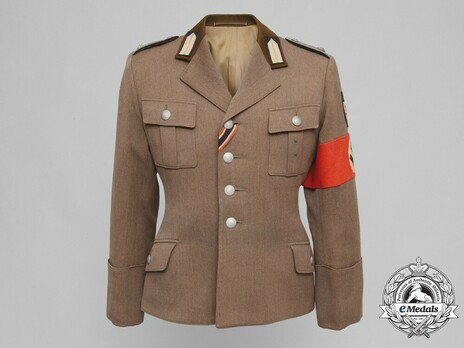
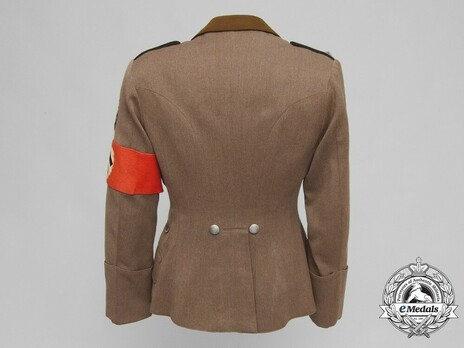
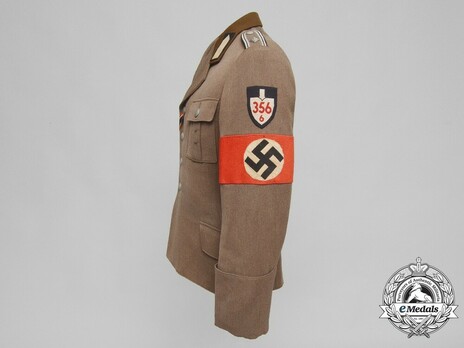
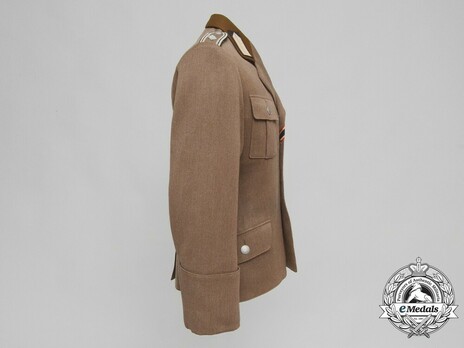
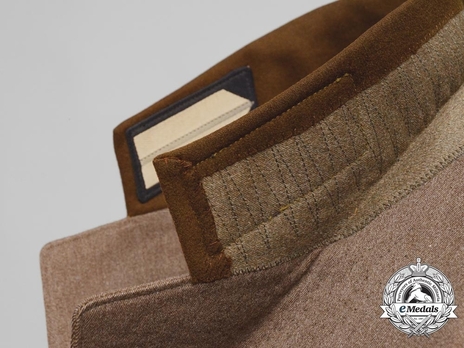
Estimated market value:
An extremely high quality officer's tunic fabricated from a fine twill brown wool, with a chocolate brown wool collar, the shoulders adorned with shoulder straps that are sewn in place, the uppers of the straps in fine twill wool with two rows of fine silvered aluminum wire flanking a thin row of black embroidery along the edge and trimmed in black piping, along with a silvered pip at the shoulder end, indicative of the rank of Obertruppführer and sewn in place to the body of tunic at the shoulder end. The opposite end of each strap has uppers with magnetic silvered buttons with pebbled uppers sewn in place, the buttons maker marked "F. & CO", size marked "18 m/m" and marked with an interlocking initials insignia on their reverses, with the underside of each strap in brown wool with a reinforced button hole. Each of the brown chocolate collars have light brown and black embroidered collar tabs sewn in place. The upper left sleeve has a red, white and black embroidered patch sewn in place, illustrating the RAD downward-pointing shovel insignia and marked with the 6th Section of 356 RAD Department identification, with a red wool NSDAP party armband below, the armband with a white cotton disk bearing a black embroidered swastika in its centre. The front has four pockets sewn in place to the body of the tunic, smaller ones on each breast and larger ones on either side below at the waist, both breast pockets with a decorative pleat, all four pockets with a fold over flap and reinforced button hole for the silvered aluminum buttons, each button with pebbled uppers, both of which are maker marked "F. & CO" and marked "38" (1938) on their reverses. The left breast pocket has two vertically-aligned horizontal loops in green threading for placement of an award, that has since been lost to time. Just above the left waist pocket, there is a silvered metal hook sewn in place, the anchor of the hook sewn in place between the wool exterior and the interior lining. The front has a vertical row of four silvered aluminum buttons on the right side, the same type as those used on the pockets, facing an equal number of reinforced button holes on the left side, the top button hole with a War Merit Cross ribbon fed through it, the other end of the ribbon wrapped around the opening of the tunic, with both ends of the ribbon stitched in place on the inside. The sleeves have French cuffs, each of which are held in place via stitching in two locations. The inside is lined in a greenish-brown rayon, with black cotton patches sewn in place in the armpits, the sleeves lined in white cotton. There is a slot behind the left waist pocket, the mouth of which is lined in brown wool. The rear of the tunic is single-vented, with magnetic silvered metal buttons on either side of the termination point of the venting. The inside is lined in greenish-brown rayon, with black cotton patches sewn in place in the armpits, each of the sleeves lined in white cotton. Exiting the lining on either side just below each armpit is a greenish-brown rayon belt, the left end with a silvered metal clip, the right end with a slotted receiver and when joined together, ensures a snug fit at the waist. There is a brown cotton strap sewn in place at the collar for hanging the jacket on a hook. The tunic measures 440 mm across the shoulders x 680 mm in length, with one small hole near the right breast pocket, the armband exhibiting mothing and light soiling, the rayon lining also light soiling, the black cotton patch in the left armpit with separation present in the stitching, the slotted metal receiver of the belt displaying surface rust. Near extremely fine.
The RAD (Reichsarbeitsdienst = Reich Labour Service) was officially established on June 26, 1935 as the sole, and compulsory, labour service of Germany. Its purposes were to help the economy, curb unemployment, and indoctrinate its members with the NSDAP ideology, as well as play its part in militarising the German population.
The FAD (Freiwilliger Arbeitsdienst = Voluntary Labour Service) was the precursor of the RAD in the early 1930s. Official uniform regulations were first introduced on October 1, 1933, with modifications made in July 1934. It is also known as NSAD (Nationalsozialistischer Arbeitsdienst = National Socialist Labour Service).
The earliest uniforms were a not entirely successful attempt at standardisation. They gave way to a second wave of FAD uniforms that, when the RAD was established, experienced no significant changes.
The earliest tunic of the FAD is dark brown, darker than the one that was implemented next. It has two side pockets and was worn buttoned to the neck.
The first tunic was replaced by an earth-brown model with a dark brown collar. This tunic was worn by members of the FAD as well as later by those of the RAD. It is single-breasted and was worn with open collar. There are two pleated breast pockets and two unpleated side pockets. It has a four front button closure. All buttons are made from aluminum, except for General ranks who wore gold-coloured buttons.
A second pattern was introduced in 1935 and worn until 1937 by all ranks. It is still earth-brown with a dark brown collar, and was worn open at the neck. There are two pleated breast pockets with a buttoned straight-edge flap and two concealed hip pockets with a slanted buttoned flap. The tunic is single breasted and has four buttons. On the Officer version are turned-back cuffs while EM ranks wore no cuffs, but a buttoned slash at the rear seam instead.
A third pattern was introduced in 1937 and worn until 1938. The only difference to the 2nd pattern is that the EM ranks tunic now has straight flaps at the hip pockets.
Another pattern was introduced in 1939, the 1939 Open-Neck pattern. This one is more a blouse than a tunic and was used for informal occasions. It has two straight-edged pleated patch hip pockets with buttoned flaps. As of April 29, 1942 NCOs wore aluminum tress about the outer edge of the collar.
A complimentary yet opposite pattern introduced in August of that same year is the 1939 Closed-Neck pattern. It has five buttons and pleated patch side pockets.
Another tunic version is the White Summer Tunic for Leaders. It is similar to the Closed-Neck version, but has six buttons, no turn-up cuffs, and a stand-up collar. No collar patches were worn on it.
A new Leader Tunic was introduced in August 1939, to be adopted by May 1940. It differed from the standard tunic in that it has seven buttons down the front, deep turned-up cuffs, and two waist line buttons on the reverse to use as a belt ramp. There are two pleated breast pockets, two inside side breast pockets, and the regular tunic’s hip pockets. It was worn by Senior NCOs and above as a camp duty and walking out tunic. Generalarbeitsführer rank and above have black piping on the collar edge, around the turn-up of the cuffs, and down the front edge.
Another version, the 1939 Informal and Office Tunic pattern for Officers, was introduced that same year. It is single-breasted with an open neck, five buttons, a dark brown collar, two pleated breast pockets, and two concealed hip pockets with straight buttoned flaps.

Comments
Sign in to comment and reply.


Scroll Top